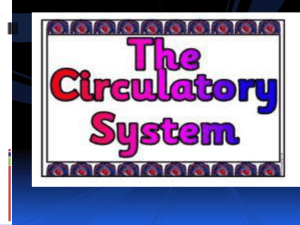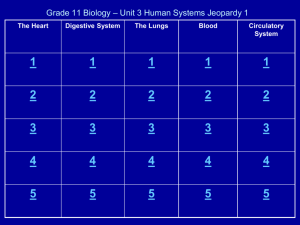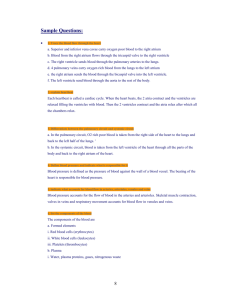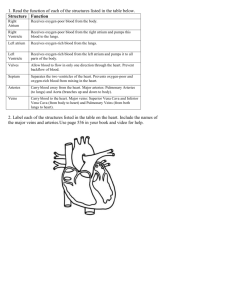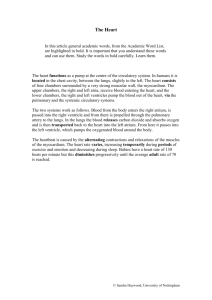Anatomy and Physiology
advertisement
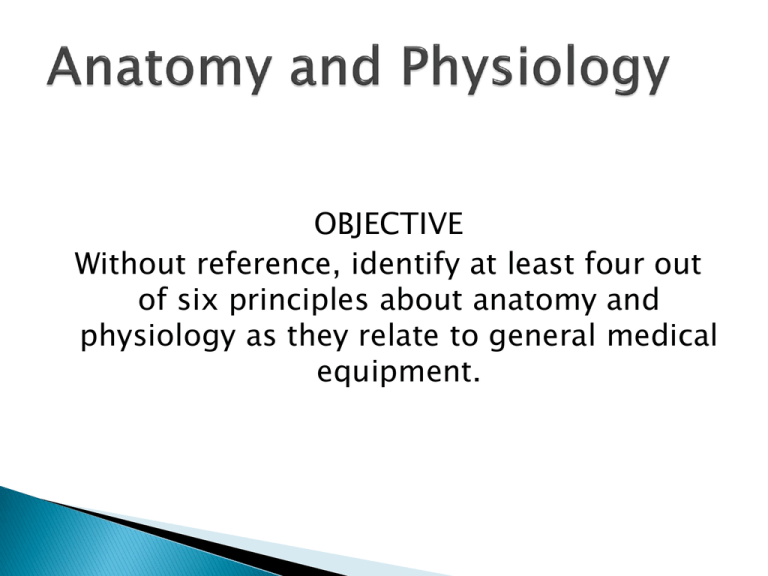
OBJECTIVE Without reference, identify at least four out of six principles about anatomy and physiology as they relate to general medical equipment. Circulatory System Functions Respiration Oxygenated blood is delivered from the lungs to the body Carbon dioxide enriched blood is carried from the body to the lungs Nutrition - erythrocytes carry food absorbed from the intestines to the tissue cells • Protection Leukocytes fight infection Thrombocytes aid in the clotting process to stop bleeding • Excretion - waste products are removed from the cells and carried to kidneys for filtration and removal • Regulation Temperature - the circulation of blood in the body acts similar to the circulation of anti-freeze in a combustion engine Hormone distribution Two main divisions • Pulmonary - refers to the respiratory functions of the circulatory system (oxygenation and de-oxygenation of blood) • Systemic - refers to the distribution of nutrients throughout the body Heart – a four chambered muscular pump about the size of a fist that lies tilted to the right in the chest with the apex (pointed end) resting on the top diaphragm and the base (broad end) on the top The pericardium is a sac like structure surrounding the heart that contains a fluid which cushions and lubricates the heart The right atrium is the chamber that collects de-oxygenated blood from the body The right ventricle is the pumping chamber that sends de-oxygenated blood to the lungs for oxygenation The left atrium is the chamber use for collecting oxygenated blood from the lungs The left ventricle is the pumping chamber that sends oxygenated blood to the body Layers of the Heart The outer layer is the epicardium The middle layer which is comprised of muscle tissue is the myocardium The inner layer lining the camber walls is the endocardium. The sinoatrial node is the impulse generating (pacemaker) tissue located in the right atrium The atrioventricular node conducts the normal electrical impulse from the atria to the ventricles, located between the atria and ventricles The bundle of hiss is the small band of specialized cardiac muscle fibers that maintain the normal sequence of the heartbeat by conducting energy from the right atrium to the ventricles Purkinje fibers – conducts the pacemaker stimulus along the inside walls of the ventricles to all parts of the heart Myocardial cell activity Polarization Heart cells are charged (polarized) negatively in the resting state » Negatively charged interior » Positively charged surface No physical response, only electrical activity Depolarization When electrically stimulated, the heart cells become positively charged (depolarized) The physical response of the cells to depolarization is contraction of the heart Repolarization Following contraction, the electrical realigning of the heart cells to their polarized state Returns to resting state Electrical activity of the heart cells Produces approximately -90 mv of electricity in the resting state (polarized) +20 to +40 mv of electricity when fully depolarized Passes through the heart and is picked up by external skin electrodes and recorded as an electrocardiogram Blood vessels • Arteries - thick walled, elastic vessels which carry blood away FROM the heart Arterioles - small branches of arteries which control blood flow by constriction and dilation • Capillaries - smallest blood vessels with walls only one cell thick. All exchanges of food and oxygen occur here • Veins - large, thin walled, nonmuscular vessels which carry blood back to the heart. Veins also contain valve to prevent back flow Venules - small beginning branches of veins Blood • Cellular portion makes up about 45% of the blood volume Red blood cells (RBC) - carry oxygen White blood cells (WBC) - fight infection Platelets - aid in coagulation • Liquid (plasma) portion makes up about 55% of the blood volume Acts as a support for the cellular portion of the blood Contains dissolved nutrients and chemicals Major arteries Pulmonary - connects the right ventricle with the lungs Aorta - carries blood from the left ventricle to the body Coronary (right and left) - first branch from the aorta, supplies the heart muscle with blood Femoral - supplies the legs Brachial - supplies the arms Carotid - supplies the head Coronary Artery Major veins Superior vena cava - returns blood from the head, arms and upper chest Inferior vena cava - returns blood from the legs, abdomen and lower chest Most veins have the same name as their corresponding artery Vein Viewer – uses infrared and projector to view veins in real time Respiratory system Terms External respiration is the exchange of gases between an organism and its environment Diffusion is the gaseous exchange of air in the alveoli of the lungs with the blood Internal respiration is the exchange of air in the capillaries with body cells Structures of the respiratory system • Nasal cavity Warms and moistens the air entering the body Lined with cilia to remove dust and foreign particles (aided by mucous) • The Pharynx is the pathway for breathing as well as a muscular tube for the passage of food • The larynx is known as the organ of sound (voice box) Trachea (windpipe) A rigid tube constructed of cartilaginous rings Lined with cilia to acts as a filter Runs anterior to the esophagus from the larynx to where it branches Bronchial tree Bronchi – a branching set of tubes from the trachea which leads to the lungs Bronchioles – smaller branches of bronchi which conduct air into the lungs Alveoli Small sac like structures at the end of the bronchioles Alveoli sacs are surrounded by capillaries Separation between the sacs and capillaries is very thin Oxygen and carbon dioxide readily diffuse between air and the blood in the capillaries This is the only place gas exchange takes place in the body Lungs The primary organ for respiration Consists of two cone shaped organs Divided into lobes – the right lung has three lobes and the left lung has two lobes The pleura is the membrane which surrounds the lungs » Each lung has its own pleura » Filled with pleura fluid to reduce friction Muscles of respiration The diaphragm is a dome shaped muscle which forms the floor of the thoracic cavity » The main muscle of respiration » Contraction causes inspiration by moving down and enlarging the cavity Intercostal muscles are located between the ribs; contraction causes inspiration Phases of respiration Inspiration » Fresh air is taken into the lungs » Oxygen diffuses in the blood and carbon dioxide diffuses into the air Expiration – air is expelled
